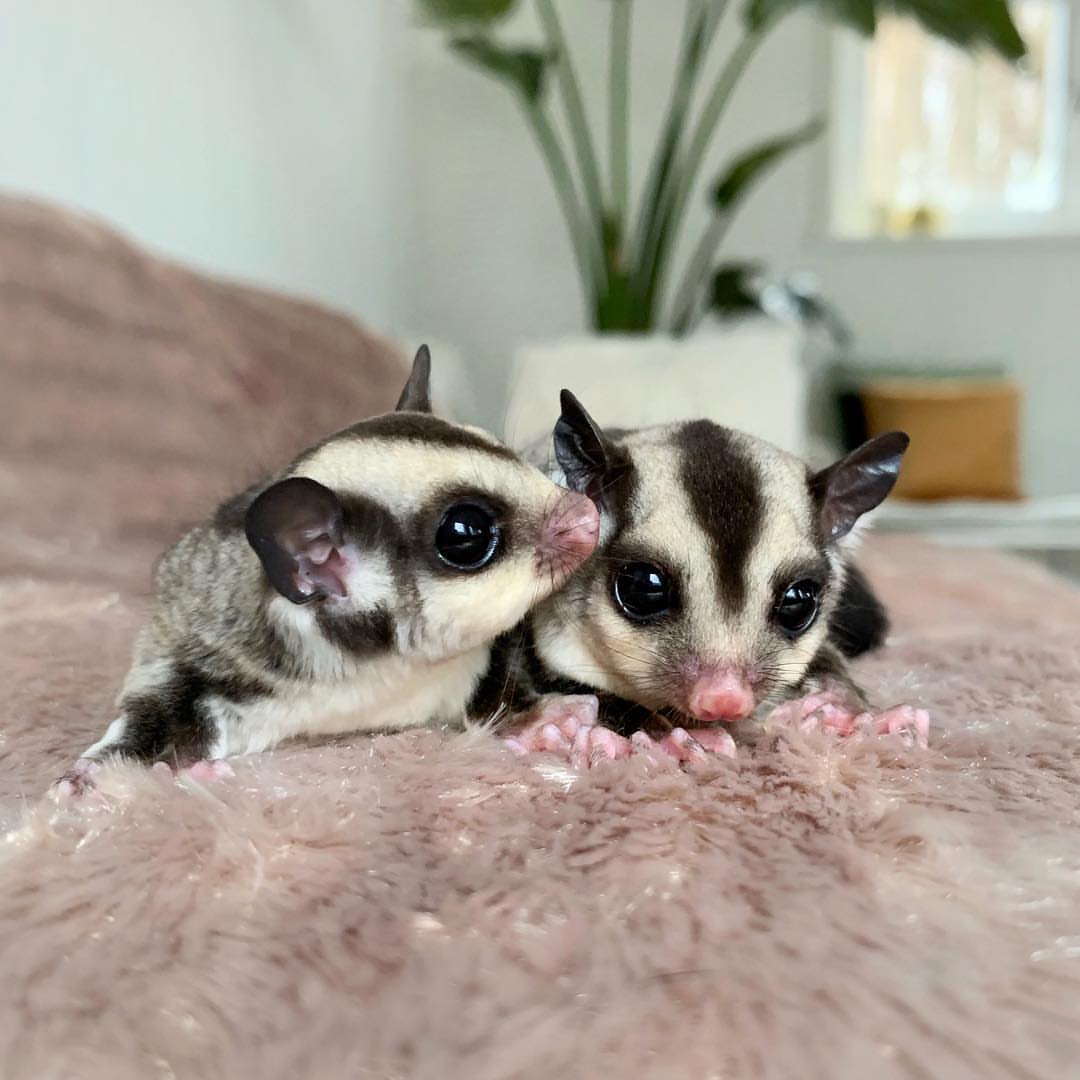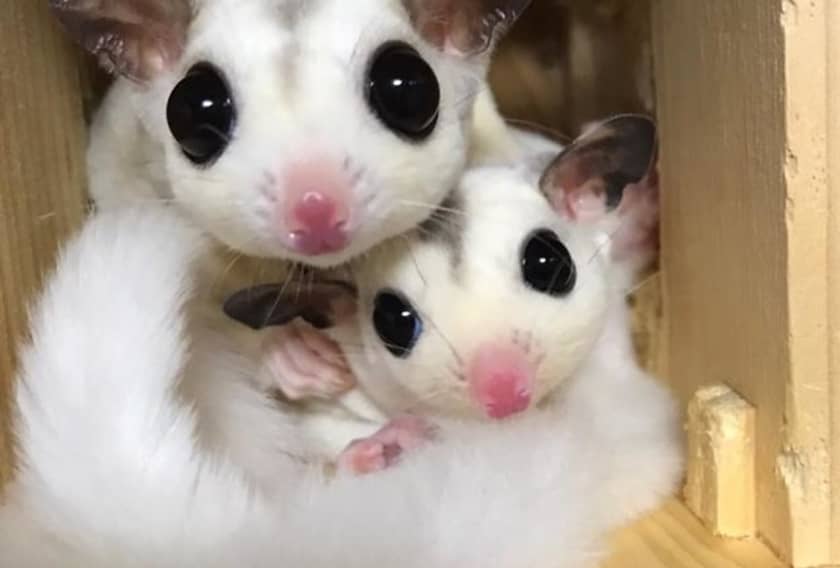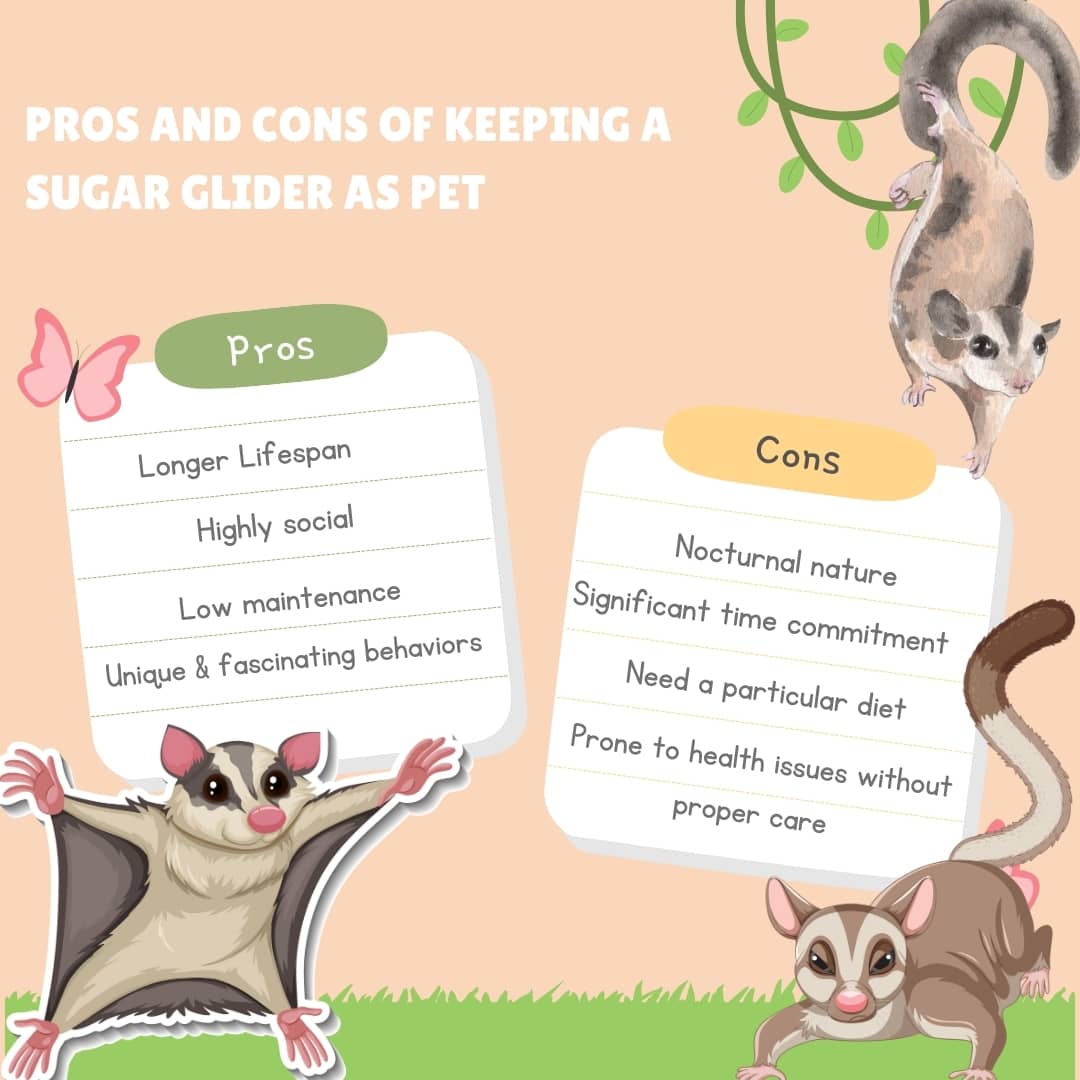Sugar gliders are small gliding companions in the pet trade. They are delightful small marsupials found in Australia, New Guinea, and parts of Indonesia. These gliding creatures have delicate, pale gray or light brown hair that is lighter on the underside.
They are lightweight creatures, with males weighing 140 g and females weighing an average of 115 g. Adult ones are small, reaching 5 to 7 inches in length, with a tail nearly as long as their body. They are around 24-30 cm (9″ to 12″) long. These nocturnal creatures have a unique membrane called the patagium that extends from their wrists to their ankles, allowing them to glide smoothly from tree to tree.
History, Classification, and Evolution
Sugar gliders are marsupials that are part of the Petauridae family. Their evolutionary path goes back millions of years. They have successfully adapted to their arboreal environment, developing traits like a gliding membrane to navigate the forest canopy. This extraordinary adaptability has allowed them to thrive in their native surroundings. They seem like miniature flying squirrels with their wide, black eyes and fluffy tails, but they are more closely related to kangaroos and koalas.
Diet
In the wild, sugar gliders eat a variety of fruits, nectar, insects, and tiny animals. They are known for their sweet taste, especially for nectar from flowers. In captivity, a well-balanced diet is essential, frequently consisting of a combination of fruits, vegetables, and specially made sugar glider pellets to ensure they obtain all vital nutrients.
It is important for you to know, ‘What is the best diet of Sugar Glider?’ Many diets can fulfill the dietary requirements for sugar gliders. Some diets are:
The BML Diet (Bourbon’s Modified Leadbeater’s Diet)
The Leadbeater’s Diet is popular among sugar glider lovers since it provides a well-balanced and healthy diet. The BML Diet is intended to be a comprehensive dietary plan on its own.
The HPW Diet (High Protein Wombaroo Diet)
The HPW Diet was initially introduced in Australia with the Wombaroo High Protein Supplement. It is a product designed for feeding orphaned or wounded animals. It was developed to give a constant, healthy feed for sugar gliders.
The TPG Diet—The Pet Glider Exotic Diet
The Pet Glider Exotic Diet (TPG Diet) is also known as the PP Diet or the Priscilla Price Diet. It is a comprehensive meal that includes proteins, fruits, vegetables, and calcium supplements.
The PML Diet (Pocket’s Modified Leadbeater)
The PML diet is a modified version of the Original Leadbeater’s Mixture, an Australian diet fed to the first captive-bred gliders. The creator of this diet was the first to advise pet owners to speak with their veterinarian before settling on a diet, which is how HPW was created.
The VGV Diet—Val’s Green Variety
The VGV Diet is specifically designed to fulfill the dietary needs of sugar gliders, focusing on a balanced blend of nutrients with a green twist. Val’s Green Variety is well-known for using fresh, nutritious ingredients to boost your sugar glider’s general health and vigor.
Reproduction and Breeding
Female sugar gliders get puberty at 8 to 12 months old, whereas males do so at 12 to 15 months. Sugar gliders reproduce year-round, with a normal gestation length of 16 days.
After 16 days, she will give birth and create a “lickey trail” of saliva up to her pouch, where the tiny joey (the size of a grain of rice) will crawl and settle. When they are ready, they gradually begin to explore the world beyond the pouch but will continue to cling to their mother’s fur.
Health and Well-Being
Maintaining the health of a sugar glider involves regular veterinary check-ups and a proper diet. Without getting all nutrients like minerals, calcium, all essential vitamins, and proteins, these pets can suffer from health issues such as obesity, dental problems, and nutritional deficiencies. You must ensure a clean and stimulating environment, along with proper diet and exercise.

Sugar Glider’s Cage
The cage for Sugar Gliders should be made of PVC-coated wire with some spots to climb and grab. The cage should be spacious—at least 36x24x40 inches.
Vertical space is crucial since sugar gliders are arboreal and enjoy climbing. The spacing between bars should be no wider than 1/2 inch to prevent escapes and ensure safety. You can also include some toys, branches, and ladders to encourage their physical activity. You should use safe and absorbent bedding for your sugar gliders, like shredded paper or fleece liners, to ensure safety, comfort, and well-being.
Conservation Status
Currently, sugar gliders are not considered endangered. However, habitat degradation and illegal pet trafficking are possible threats. Conservation efforts are centered on protecting their natural habitats and controlling the pet trade to ensure their continuing existence in the wild.
Distribution in Some States
In the United States, sugar gliders are predominantly kept as pets, especially in California, Texas, and Florida. They are not native to the United States but have grown in preference as exotic pets because of their interesting appearance and energetic personalities. There are different species of sugar gliders, some of them are common and some are very rare.
Sugar Glider’s Poop
Sugar glider poop is small, hard, and often black in color. It is critical to watch their feces for changes in consistency or color, as these might be indicators of health problems. Regular cleaning of their environment helps to maintain their living space hygienic and decreases the chance of illness.
Pros and Cons of Keeping Tiny Gliding Companions: Sugar Gliders
The sugar glider attracts everyone through its adorable looks and unique and thrilling gliding capabilities. It is really commendable about the kind of bonding they tend to develop with their owners but you should thoroughly consider all pros and cons of keeping them as pets.
Pros
- Sugar gliders are very social and affectionate animals with their owners.
- Sugar gliders come in small sizes and need little space to stay.
- The sugar glider’s gliding ability and nocturnal nature make them fascinating and unique pets.
- They are generally quiet pets, which is great for people who live in apartments or have noise-sensitive neighbors.
- Sugar gliders have low odor and clean themselves.
Cons
- Being nocturnal, sugar gliders are active at night, which might not align with your daily routine and can result in noise or disruption during the evening.
- They are highly social animals and thrive in pairs. Keeping a single sugar glider can lead to loneliness and behavioral problems, requiring the owner to invest in multiple pets or provide extra attention.
- In some areas, owning sugar gliders may be regulated or prohibited. It’s crucial to research local laws and ensure you can keep them ethically.
- Sugar gliders require a specialized diet and regular care to maintain their health.
- They can be messy with their food and their droppings.
Buying a Sugar Glider
Before purchasing a sugar glider, it’s crucial to do thorough research. You should understand their dietary needs, social requirements, and health care and ensure you have the time, resources, and commitment to provide proper care for these unique pets. Make sure you purchase from a reputable breeder or rescue organization, checking for a clean, healthy environment and obtaining necessary health records.
The common baby sugar glider can cost around $300-$500. The cost of an adult sugar glider is approximately $150-$300.
Interesting Facts About Sugar Gliders
Sugar gliders are interesting creatures with remarkable gliding capabilities. Some of the interesting facts about them are:
- In the wild, a sugar glider can live 5–9 years on average. But in captivity, their life expectancy can increase to 12–15 years.
- Sugar gliders can glide up to 150 feet (45 meters) in a single glide, despite their small size.
- Sugar gliders can calculate their glide ratios and distances by “bobbing their heads side to side.
- Sugar gliders are nocturnal, which means they are active at night and sleep during the day.
- Sugar gliders can carry light items like leaves or twigs because of their semi-prehensile tail.
- Sugar gliders do not have feet; rather, they have four small hands.
- Sugar glider raises their young in a pouch on their mother’s belly.
- Sugar gliders are social animals and can’t live alone.
- Sugar gliders communicate using various sounds such as chirping, hissing, and barking.
- Sugar gliders are omnivores and feed a varied diet that includes nectar, pollen, insects, sap, and gum from the trees.

Frequently Asked Questions
Question 1:Can sugar gliders eat grapes?
Answer: Yes, sugar gliders can eat grapes in moderation. Grapes should be given as an occasional treat rather than a regular part of their diet due to their high sugar content.
Question 2: Do Sugar Gliders Need to Be in Pairs?
Answer: Sugar gliders are extremely social animals who flourish when they have a partner. In the wild, they live in groups and rely on one another for social contact.
Question 3: Can sugar gliders eat cantaloupe?
Answer: Yes, cantaloupe is safe for sugar gliders and can be a tasty treat. It’s rich in vitamins and hydration but should be offered in moderation.
Question 4: Can sugar gliders have pumpkins?
Answer: Yes, sugar gliders can eat pumpkins. It’s nutritious and contains beneficial vitamins and fiber. Plain-cooked pumpkin is best.
Question 5: Do sugar gliders poop a lot?
Answer: Sugar gliders have small, frequent bowel movements. While it’s normal for them to poop several times a day, any significant changes in consistency or frequency can indicate health issues and should be checked by a vet.
Question 6: Can you potty train a sugar glider?
Answer: Potty training a sugar glider is difficult and frequently impracticable since they have natural impulses to establish their territory and may not always utilize a chosen place. You may encourage useful habits by keeping their cage clean and providing a small, easily accessible litter box.
Question 7: Can sugar gliders have honey?
Answer: Honey for sugar gliders is generally not recommended. It’s high in sugar and can contribute to obesity and other health issues.
News and Other
- More than 50 sugar gliders are on their way to Massachusetts after being rescued in Puerto Rico earlier this year. Check out here
- Sugar Glider is actually three species, but one is disappearing fast. Check out here
- The sugar gliders are expected to arrive in Methuen on Wednesday. Check out here
Conclusion
Sugar gliders are fascinating and unique pets that require careful consideration and commitment. Their adorable appearance, social nature, and playful energy make them a joyful creature, but they also come with specific needs, including a balanced diet, spacious habitat, and regular social interaction. Whether you’re considering bringing home a sugar glider or already have one, understanding their care requirements is key to ensuring they live a healthy and happy life. With proper attention and love, sugar gliders can become amazing companions.


